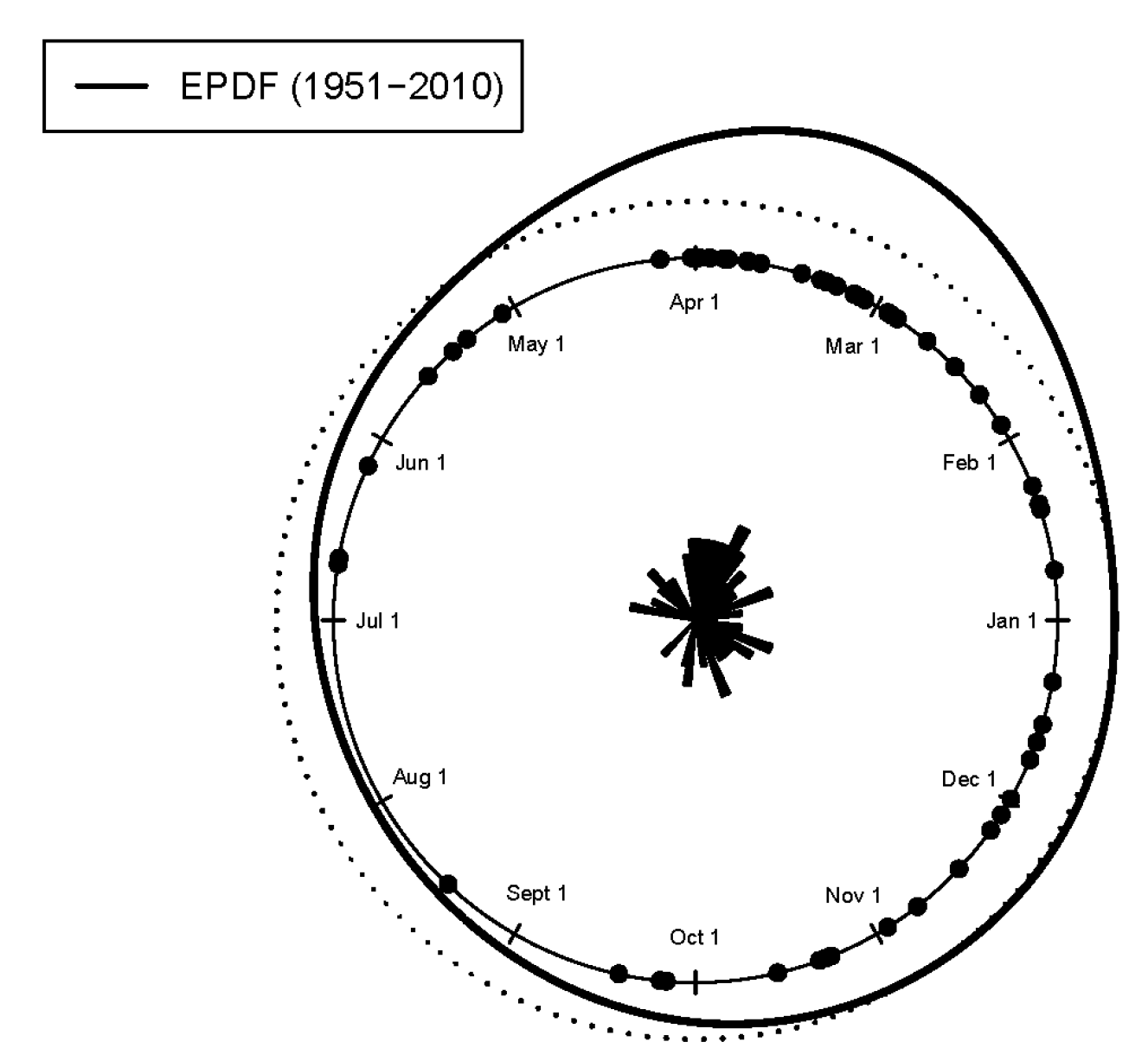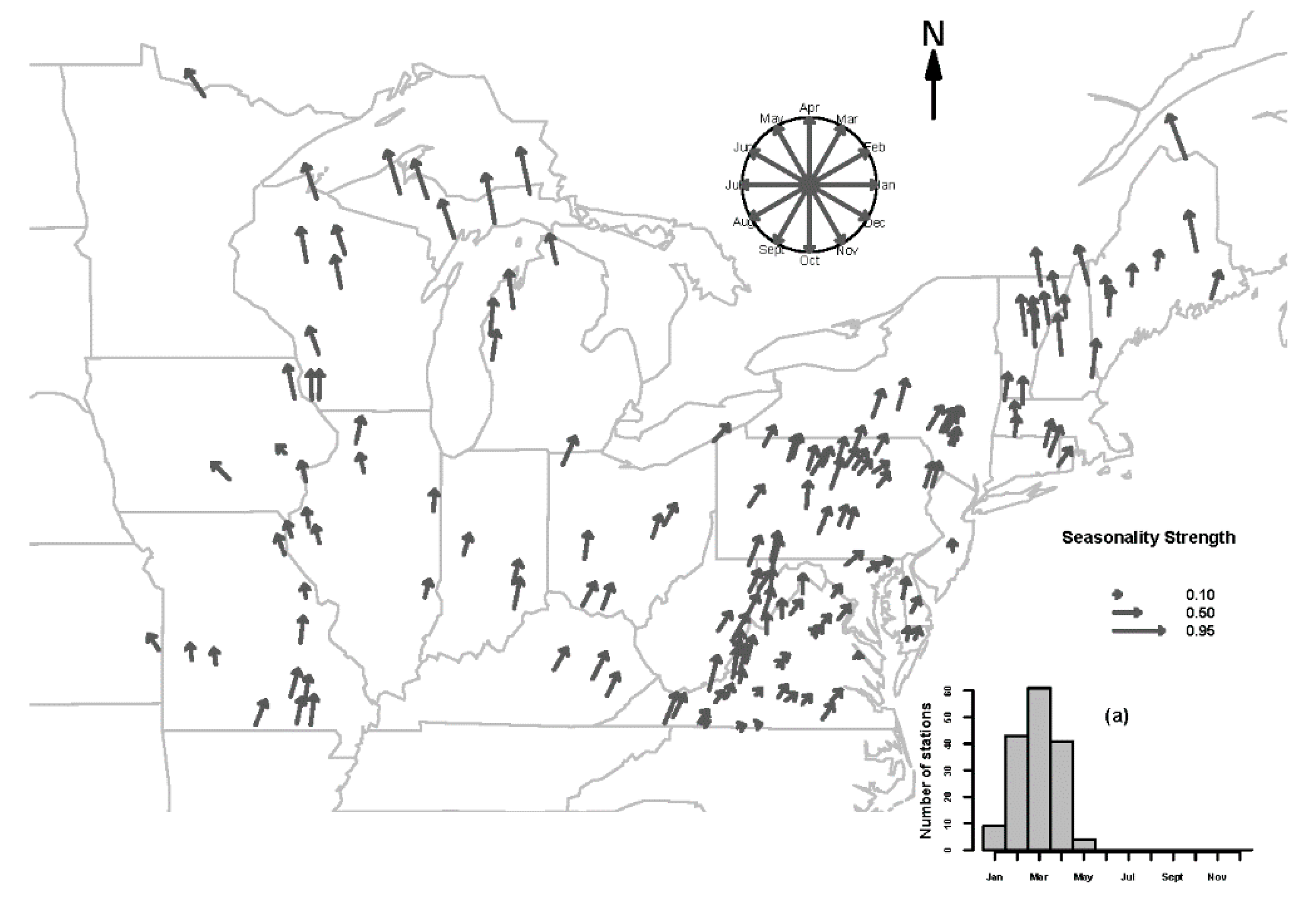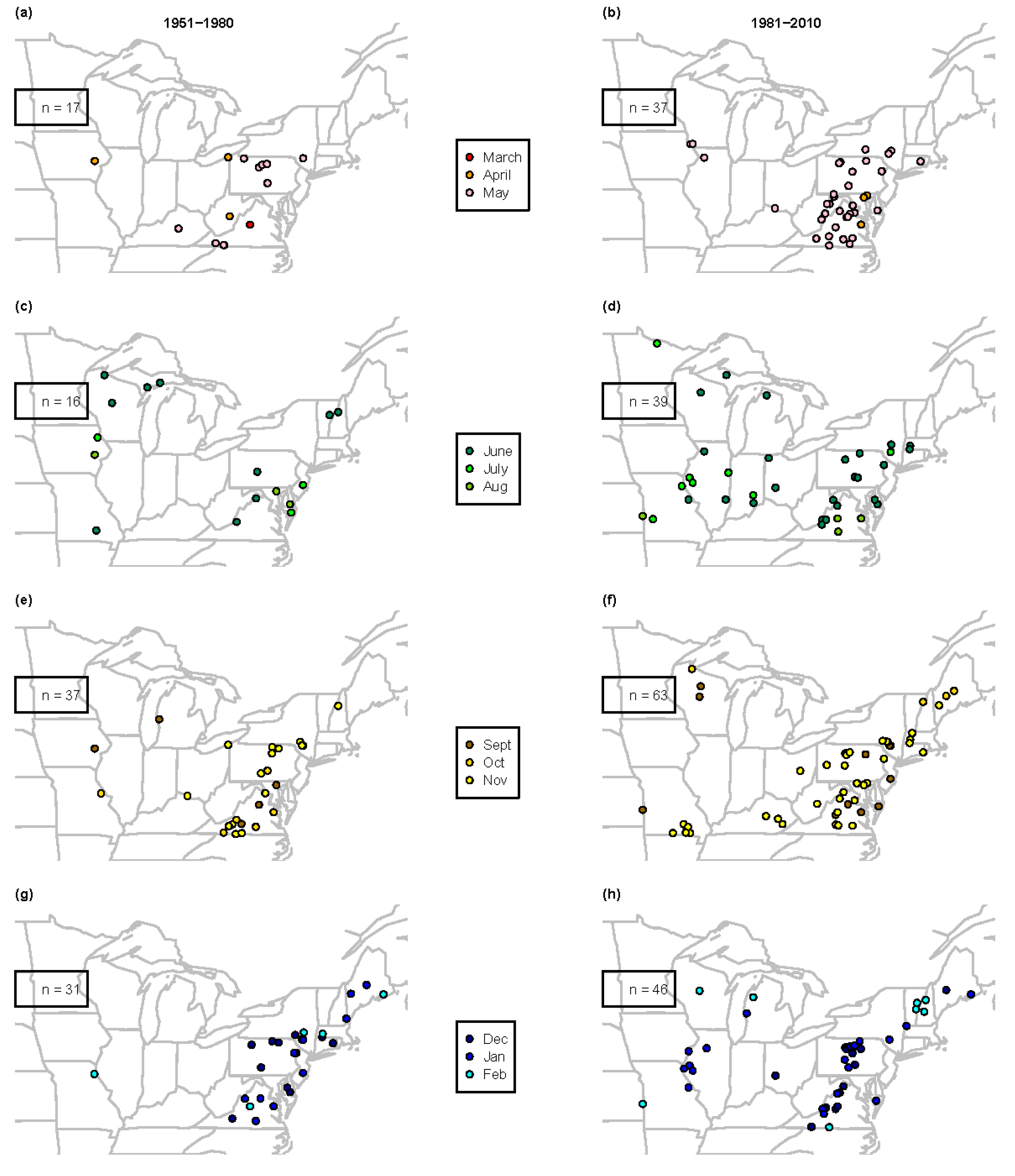Changing River Flood Timing in the Northeastern and Upper Midwest United States: Weakening of Seasonality over Time?
Abstract
:1. Introduction
2. Materials and Methods
2.1. Data and Study Area
2.2. Statistical Methods
2.2.1. Circular Statistics
2.2.2. Circular Distribution Function
3. Results
3.1. Spatial Pattern of Seasonality Based on Circular Mean and Variability
3.1.1. Temporal Change in Seasonality
3.2. Seasonality Based on Circular Density Method
4. Conclusions and Discussion
- Assessment of spatial patterns of seasonality for the last six decades (1951–2010) based on the mean date and variability in the occurrence of the extreme events shows strong seasonality of the AMF. Majority of stations have their maxima mostly in the months of February, March and April.
- Comparing the AMF seasonality before and after 1980 (using two 30-year sub-periods, 1951–1980 and 1981–2010) based on changes in the mean date and variability as well using Rao spacing test, a nonparametric uniformity test, shows that majority of stations have no significant change in their mean date with their maxima mostly in the months of February, March and April for both the time periods. However, for the recent sub-period, the seasonality has weakened for several sites indicated by the lower values of variability and higher number of stations accepting the null hypothesis of uniformity.
- Using the non-parametric circular density approach, four different cases of seasonality change over time for AMF dates were identified in this study: (i) weakening of seasonality, (ii) strengthening of seasonality, (iii) unimodal and strong seasonality for both the earlier and latest time period, (iv) uniform or no preferred seasonality for both the earlier and latest time period. Assessment of temporal change in seasonality of the AMF based on non-parametric circular density estimates shows that for the majority of stations significant density estimates are observed during the months of February, March and April for both time periods. In addition to this, it was observed that seasonal modes of AMF dates have weakened over time for a number of sites along the coastal region with the emergence of significant modes during late spring and early summer (May–June) as well as fall season (mid-September–November). The reason for the emergence of seasonality modes during the month of November along the coastal sites might be due to an increase in the heavy precipitation trends associated with tropical cyclones in the North Atlantic basins over the last 30 years [26,40,41,42,43]. Similarly, the emergence of modes during the months of May and early June might be due to the emergence of extreme precipitation seasonality modes during late spring and early summer season for the latest time period as shown by Dhakal et al. [25].
Supplementary Materials
Author Contributions
Funding
Acknowledgments
Conflicts of Interest
References
- Jain, S.; Lall, U. Magnitude and timing of annual maximum floods: Trends and large-scale climatic associations for the Blacksmith Fork River, Utah. Water Resour. Res. 2000, 36, 3641–3651. [Google Scholar] [CrossRef]
- Jain, S.; Lall, U. Floods in a changing climate: Does the past represent the future? Water Resour. Res. 2001, 37, 3193–3205. [Google Scholar] [CrossRef]
- Milly, P.C.D.; Betancourt, J.; Falkenmark, M.; Hirsch, R.M.; Kundzewicz, Z.W.; Lettenmaier, D.P.; Stouffer, R.J. Stationarity is dead: Whither water management? Science 2008, 319, 573–574. [Google Scholar] [CrossRef] [PubMed]
- Ehsanzadeh, E.; Adamowski, K. Trends in timing of low stream flows in Canada: Impact of autocorrelation and long-term persistence. Hydrol. Process. 2010, 24, 970–980. [Google Scholar] [CrossRef]
- Bloschl, G.; Hall, J.; Parajka, J.; Perdigao, R.A.P.; Merz, B.; Arheimer, B.; Aronica, G.T.; Bilibashi, A.; Bonacci, O.; Borga, M.; et al. Changing climate shifts timing of European floods. Science 2017, 357, 588–590. [Google Scholar] [CrossRef] [PubMed] [Green Version]
- Campbell, J.L.; Driscoll, C.T.; Pourmokhtarian, A.; Hayhoe, K. Streamflow responses to past and projected future changes in climate at the Hubbard Brook Experimental Forest, New Hampshire, United States. Water Resour. Res. 2011, 47, W02514. [Google Scholar] [CrossRef]
- Lettenmaier, D.P.; Wood, E.F.; Wallis, J.R. Hydro-climatological trends in the continental United States, 1948–1988. J. Clim. 1994, 7, 586–607. [Google Scholar] [CrossRef] [Green Version]
- Lins, H.F.; Slack, J.R. Streamflow trends in the United States. Geophys. Res. Lett. 1999, 26, 227–230. [Google Scholar] [CrossRef] [Green Version]
- Douglas, E.M.; Vogel, R.M.; Kroll, C.N. Trends in floods and low flows in the United States: Impact of spatial correlation. J. Hydrol. 2000, 240, 90–105. [Google Scholar] [CrossRef]
- Groisman, P.Y.; Knight, R.W.; Karl, T.R. Heavy precipitation and high streamflow in the contiguous United States: Trends in the twentieth century. Bull. Am. Meteorol. Soc. 2001, 82, 219–246. [Google Scholar] [CrossRef] [Green Version]
- Small, D.; Islam, S.; Vogel, R.M. Trends in precipitation and streamflow in the eastern US: Paradox or perception? Geophys. Res. Lett. 2006, 33. [Google Scholar] [CrossRef]
- Kalra, A.; Piechota, T.C.; Davies, R.; Tootle, G.A. Changes in US streamflow and western US snowpack. J. Hydrol. Eng. 2008, 13, 156–163. [Google Scholar] [CrossRef]
- Ahn, K.H.; Palmer, R.N. Trend and variability in observed hydrological extremes in the United States. J. Hydrol. Eng. 2015, 21, 04015061. [Google Scholar] [CrossRef]
- McCabe, G.J.; Wolock, D.M. A step increase in streamflow in the conterminous United States. Geophys. Res. Lett. 2002, 29, 2185. [Google Scholar] [CrossRef]
- Baldwin, C.K.; Lall, U. Seasonality of streamflow: The upper Mississippi River. Water Resour. Res. 1999, 35, 1143–1154. [Google Scholar] [CrossRef]
- Burn, D.H.; Sharif, M.; Zhang, K. Detection of trends in hydrological extremes for Canadian watersheds. Hydrol. Process. 2010, 24, 1781–1790. [Google Scholar] [CrossRef]
- Villarini, G. On the seasonality of flooding across the continental United States. Adv. Water Resour. 2016, 87, 80–91. [Google Scholar] [CrossRef] [Green Version]
- Rutkowska, A.; Kohnová, S.; Banasik, K. Probabilistic Properties of the Date of Maximum River Flow, an Approach Based on Circular Statistics in Lowland, Highland and Mountainous Catchment. Acta Geophys. 2018, 66, 755–768. [Google Scholar] [CrossRef] [Green Version]
- Bayliss, A.C.; Jones, R.C. Peaks-Over-Threshold Flood Database; Institute of Hydrology: Wallingford, UK, 1993. [Google Scholar]
- Burn, D.H. Catchment similarity for regional flood frequency analysis using seasonality measures. J. Hydrol. 1997, 202, 212–230. [Google Scholar] [CrossRef]
- Parajka, J.; Kohnová, S.; Merz, R.; Szolgay, J.; Hlavčová, K.; Blöschl, G. Comparative analysis of the seasonality of hydrological characteristics in Slovakia and Austria. Hydrol. Sci. J. 2009, 54, 456–473. [Google Scholar] [CrossRef]
- Parajka, J.; Kohnová, S.; Bálint, G.; Barbuc, M.; Borga, M.; Claps, P.; Blöschl, G. Seasonal characteristics of flood regimes across the Alpine–Carpathian range. J. Hydrol. 2010, 394, 78–89. [Google Scholar] [CrossRef] [PubMed]
- Ye, S.; Li, H.Y.; Leung, L.R.; Guo, J.; Ran, Q.; Demissie, Y.; Sivapalan, M. Understanding flood seasonality and its temporal shifts within the contiguous United States. J. Hydrometeorol. 2017, 18, 1997–2009. [Google Scholar] [CrossRef]
- Collins, M.J. River flood seasonality in the Northeast United States: Characterization and trends. Hydrol. Process. 2019, 33, 687–698. [Google Scholar] [CrossRef]
- Dhakal, N.; Jain, S.; Gray, A.; Dandy, M.; Stancioff, E. Nonstationarity in seasonality of extreme precipitation: A nonparametric circular statistical approach and its application. Water Resour. Res. 2015, 51, 4499–4515. [Google Scholar] [CrossRef]
- Dhakal, N. Changing impacts of North Atlantic tropical cyclones on extreme precipitation distribution across the Mid-Atlantic United States. Geosciences 2019, 9, 207. [Google Scholar] [CrossRef] [Green Version]
- Lins, H.F.; Slack, J.R. Seasonal and regional characteristics of US streamflow trends in the United States from 1940 to 1999. Phys. Geogr. 2005, 26, 489–501. [Google Scholar] [CrossRef]
- Villarini, G.; Smith, J.A. Flood peak distributions for the eastern United States. Water Resour. Res. 2010, 46, W06504. [Google Scholar] [CrossRef] [Green Version]
- Armstrong, W.H.; Collins, M.J.; Snyder, N.P. Increased frequency of low-magnitude floods in New England. JAWRA J. Am. Water Resour. Assoc. 2012, 48, 306–320. [Google Scholar] [CrossRef]
- Hodgkins, G.A.; Dudley, R.W.; Huntington, T.G. Changes in the timing of high river flows in New England over the 20th century. J. Hydrol. 2003, 278, 244–252. [Google Scholar] [CrossRef] [Green Version]
- Hodgkins, G.A.; Dudley, R.W. Changes in late-winter snowpack depth, water equivalent, and density in Maine, 1926–2004. Hydrol. Process. 2006, 20, 741–751. [Google Scholar] [CrossRef]
- Demaria, E.M.; Palmer, R.N.; Roundy, J.K. Regional climate change projections of streamflow characteristics in the Northeast and Midwest US. J. Hydrol. Reg. Stud. 2016, 5, 309–323. [Google Scholar] [CrossRef] [Green Version]
- Falcone, J.D.; Carlisle, D.M.; Wolock, D.M.; Meador, M.R. GAGES: A stream gage database for evaluating natural and altered flow conditions in the conterminous United States. Ecology 2010, 91, 621. [Google Scholar] [CrossRef]
- Mardia, K.V. Statistics of Directional Data; Academic Press: New York, NY, USA, 1972. [Google Scholar]
- Jammalamadaka, S.R.; Sengupta, A. Topics in Circular Statistics; World Scientific: Singapore, 2001; Volume 5. [Google Scholar]
- Oliveira, M.; Crujeiras, R.M.; Rodríguez-Casal, A. Nonparametric circular methods for exploring environmental data. Environ. Ecol. Stat. 2013, 20, 1–17. [Google Scholar] [CrossRef]
- Agostinelli, C.; Lund, U. R Package ‘Circular’: Circular Statistics (Version 0.4–7). 2013. Available online: https://r-forge.r-project.org/projects/circular/ (accessed on 24 December 2019).
- Hirschboeck, K.K. Hydroclimatically-Defined Mixed Distributions in Partial Duration Flood Series. In Hydrologic Frequency Modeling; Singh, V.P., Ed.; Reidel Publishing Company: Dordrecht, The Netherlands, 1987; pp. 199–212. [Google Scholar]
- Hirschboeck, K.K. Climate and floods. Natl. Water Summ. 1988, 89, 67–88. [Google Scholar]
- Lau, K.M.; Zhou, Y.P.; Wu, H.T. Have tropical cyclones been feeding more extreme rainfall? J. Geophys. Res. Atmos. 2008, 113. [Google Scholar] [CrossRef] [Green Version]
- Kunkel, K.E.; Easterling, D.R.; Kristovich, D.A.; Gleason, B.; Stoecker, L.; Smith, R. Recent increases in US heavy precipitation associated with tropical cyclones. Geophys. Res. Lett. 2010, 37, 2–5. [Google Scholar] [CrossRef]
- Barlow, M. Influence of hurricane-related activity on North American extreme precipitation. Geophys. Res. Lett. 2011, 38. [Google Scholar] [CrossRef]
- Dhakal, N.; Jain, S. Nonstationary influence of the North Atlantic tropical cyclones on the spatio-temporal variability of the eastern United States precipitation extremes. Int. J. Climatol. 2019, 40, 3486–3499. [Google Scholar] [CrossRef]






© 2020 by the authors. Licensee MDPI, Basel, Switzerland. This article is an open access article distributed under the terms and conditions of the Creative Commons Attribution (CC BY) license (http://creativecommons.org/licenses/by/4.0/).
Share and Cite
Dhakal, N.; Palmer, R.N. Changing River Flood Timing in the Northeastern and Upper Midwest United States: Weakening of Seasonality over Time? Water 2020, 12, 1951. https://doi.org/10.3390/w12071951
Dhakal N, Palmer RN. Changing River Flood Timing in the Northeastern and Upper Midwest United States: Weakening of Seasonality over Time? Water. 2020; 12(7):1951. https://doi.org/10.3390/w12071951
Chicago/Turabian StyleDhakal, Nirajan, and Richard N. Palmer. 2020. "Changing River Flood Timing in the Northeastern and Upper Midwest United States: Weakening of Seasonality over Time?" Water 12, no. 7: 1951. https://doi.org/10.3390/w12071951




